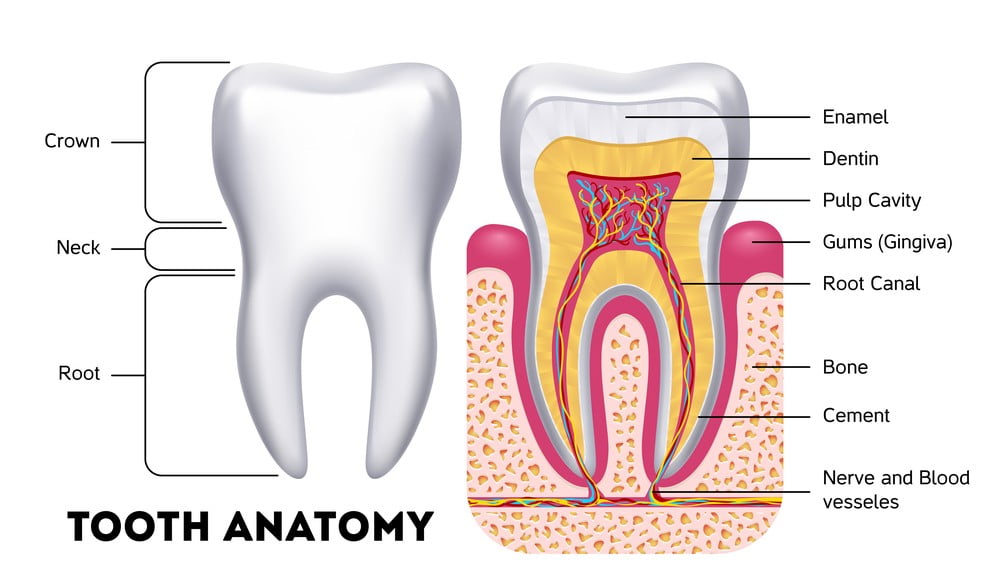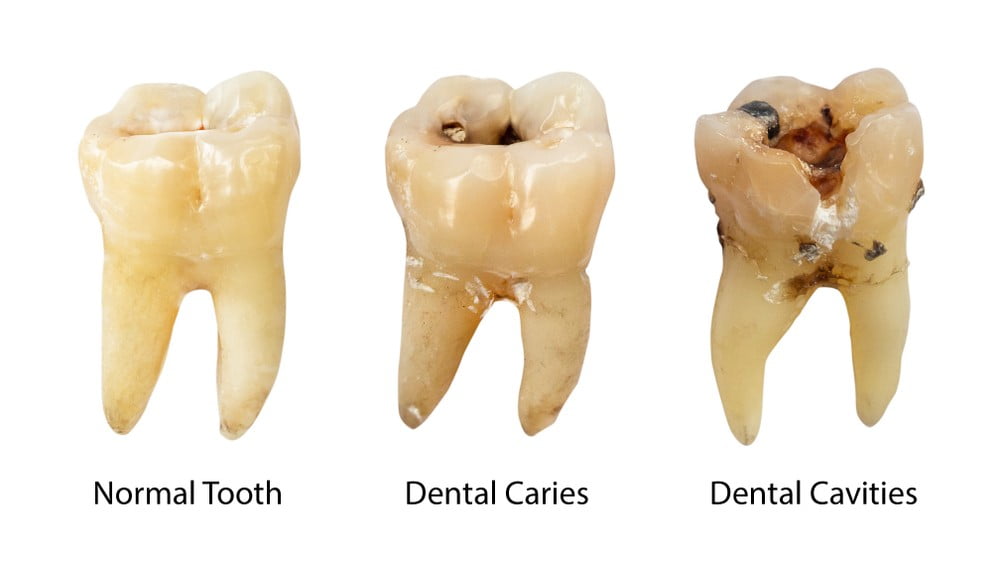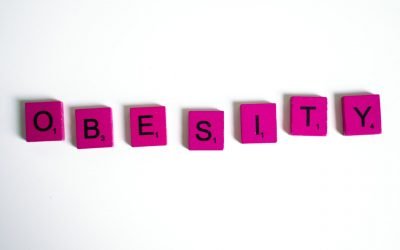Before going into depth on how you can take care of your teeth without dentist, let’s know the basic function of teeth and its structure.
In human being two sets of teeth appear in the mouth at different ages according to the need to perform their functions namely;
- Chewing of food (mastication).
- Add to the looks (aesthetics).
- Making of words in speech (phonetics).
Number of Teeth.
Total no. of Milk teeth is 20.
Total no. of permanent teeth is 32.
Age of Eruption.
Tooth Anatomy.

To take care of the teeth without dentist, at first it is important to know about its anatomy. So, teeth are hard tissue structures present in the mouth and are surrounded by soft tissue called the Gums.
Common Diseases of Teeth.
So, before take care of the teeth without dentist, you must well aware about the common diseases of teeth. These are;
- Developmental.
- Traumatic.
- Infective.
- Cysts & Tumors.
Although, Top Dentist in Dubai believe that taking care of these diseases without the help of an expert is not suggested. Call for an appointment today.
Development Abnormalities.
Early Eruption of Deciduous Teeth.
There are instances when a child is born with a front tooth. It mostly causes problem in feeding.
Treatment.
Extractions when child is 8 or 10 days old.
Early Eruption of Permanent Teeth.
Teeth can erupt early causing crowding of teeth since the milk teeth are also present and thus cause distortion.
Treatment.
Serial extraction of milk teeth and proper alignment of space to permanent teeth.
Delayed Eruption.
In a disease called Rickets which is due to Vitamin ‘D’ deficiency, there is retarded eruption of teeth.
- Malnourishment : During the development of teeth when the child does not get well-nourished food rich in calcium, phosphorous, protein etc. eruption of teeth is delayed.
- Infection around the deciduous teeth retards resorption and leads to delayed eruption of the permanent teeth.
Treatment.
- A well nourished diet.
- Decayed milk teeth to be filled at the earliest.
- In delayed exfoliation of milk teeth. It can be extracted in time, to give way for the permanent teeth, the presence of which is checked by X-Rays.
- Malocclusion : Here there is improper alignment of the teeth which leads to crowding or spacing of the teeth. This may be due to :-
- The child acquiring the jaw size of one parent and the teeth size from another parent.
- Due to delayed exfoliation of milk teeth.
Treatment.
Correction to be done at an early age. Ideal age of treatment is between 8 years to 14 years.
Teething Problem.
This is seen when the milk teeth erupt from the 5th or 6th month onwards. The child has irritation and discomfort in the gums as the teeth are trying to come out of them.
Treatment.
Child should be given clean, blunt, thick rubber keychains or something which is large enough. The child keeps biting on this and this will give a comfortable feeling to the gums.
Wisdom Teeth.
In adults when the last Molars erupt there will be some pain when the jaw is not able to accommodate them. This may be due to hereditary factor, where the Jaw may be small and is not able to accommodate the complete set of teeth.

It may also be due to evolution, since the Jaw size is becoming smaller and thus there is no space to accommodate the 3rd Molar.
Abnormality of Number and Size.
Number.
- Total absence of teeth (Anodontia).
- Partial absence of teeth (Partial Anodontia).
- Additional teeth (Supernumerary teeth).
Size.
- Small teeth (Microdontia).
- Large teeth (Microdontia).
Abnormality of Structure (Hypoplasia).
This is due to some disturbance during the formation of enamel and dentin. Do the following ;
- Avoid Trauma which injures the jaws or teeth during the formative stage of teeth.
- Try to avoid infection, as infection of the milk teeth may disturb formation of permanent teeth, enamel and dentin.
- Avoid excess fluoride :- Excess fluorides taken during the formative period of teeth causes fluorosis, especially when the fluoride content in water is high.
- Avoid dietary insufficiency :- When there is deficiency in calcium, phosphorous intake and malnourished diet, it affects the enamel and dentin formation.
Discoloration of Teeth.
It is due to;
- Hypoplasia.
- Fluorosis.
- Tetracycline.
- Blood diseases (dyscrasias).
Dental Caries.
Most prevalent and dangerous disease of teeth. Due to improper cleaning of the mouth there is a thin slimy material that adheres to the tooth structure which has colonies of bacteria in it. This is called “Dental Plaque”.
This thin layer becomes thicker in course with time and the acids produced by these bacteria bring about destruction of the enamel and thus decay in the tooth is initiated. If not noticed in time, it spreads rapidly into the underlying dentin and ultimately involves the pulp (Nerve) leading to pain and swelling.

Early Symptoms.
- Sensitive to cold and sweet.
- Food lodgment in the cavity.
Late Symptoms.
- Bad odour in the mouth.
- Difficulty in chewing food.
- Pain, swelling.
Preventive Measures.
- See your dentist on development of early symptoms.
- Eat right kind of food.
- Chew your food well.
- Clean your teeth well after each meal with tooth paste, especially after chocolate and sweet.
- Dental check up in every six months.
- Fluoride treatment by a dentist and use of fluoride tooth paste in children.
Trauma Teeth.

Teeth may get fractured due to injury or fail. The age group that is most affected with injury to teeth is between 6 years to 10 years.
Treatment.
When the tooth has come out it should be cleaned in clean water, wrapped in a wet handkerchief and taken to a dentist as early as possible as chances for the same tooth to be grafted are 99% when attempted in 6-12 hours.
Gums.
It is the soft tissue around the teeth which covers the bone in which the teeth are placed. A healthy gum is pink in colour. Healthy gums reflect the health of an individual.
Gum Infection.
Popularly known as periodontitis which was commonly known as “Pyorrhea”. In this disease there is inflammation and pain in the gums and when pressed, pus comes out.
Treatment.
- Medicines.
- Oral prophylaxis.
- Gum surgery.
- Oral hygiene measures.
Signs & Symptoms.
- Swollen gums.
- Presence of bleeding.
- Pain.
- Bad odour in the mouth.
- Pus discharge.
- Bone loss around the teeth.
- Shabby teeth.
Preventive Measures.
- Brushing after each meal.
- Slat water gargling.
- Gum massaging.
- Regular dental check up.
- Proper brushing technique.
- Chewing of fibrous food.
Cysts and Tumors.
There are like any other cysts or tumors in the body and may be;
- Benign (simple).
- Malignant (Cancerous).
- Primary – Arising locally.
- Secondary – Migrating from other areas e.g. lungs, spleen etc. Thus any swelling of ulcer in the mouth if noticed by the patient should be brought to the notice of a dentist immediately. If the tumor is cancerous and if treated early, it can be cured completely.
Treatment will depend upon site, histopathology, cause etc.
Prevention is Better than Cure.
- Teeth once go bad can only be repaired and not cured as they do not have growing power.
- Dental troubles, imply that the disease has already advanced.
- So visit your Dentist regularly and at the earliest symptom/complaint.
Tips To Take Care of Your Teeth Without Dentist.
Now, lets see how you can take care of your teeth without dentist?
- Clearing of the teeth by Indian Neem Datun (Neem Twig) is still prevalent in the villages. They also use Kikar and the bark of walnut tree to clean the teeth.
- Cleaning of the teeth with tooth power is also very common. People use fine powder of charcoal, the ashes of burnt charcoal, brick powder etc. to clean the teeth. These agents are highly abrasive and injurious to the teeth and gums.
- Cleaning the teeth with a tooth brush and tooth paste with proper brushing technique is the best way to keep the teeth and the gums healthy.
Technique of Brushing.
While brushing upper and lower teeth, press the bristles against the teeth so that they remove food particles which are stuck in the crevices. This also helps to massage the gums.
Food Habits.
One of the reasons for our villagers not having decay in their teeth despite the lack of tooth brushes is the habit of eating plenty of raw foods. Eating of sugar cane, raw carrot, radish etc. makes them bite and chew which in turn helps in keeping clean the teeth surfaces and healthy gums.
Avoid sticky foods like chocolates and sweets. Food should be chewed well. Foods like carrots and apples help to keep the teeth clean.
Cleaning of the Mouth.
- Thorough rinsing of the mouth after eating any thing.
- Brushing of teeth after each meal.
- Salt water gargling of mouth.
- Gum massage.
- Regular dental check up.
Bottom Line.
Therefore, we hope now you know how to take care of your teeth without dentist and maintain a healthy teeth. But it is always advise that before taking any step which need special attention and care, talk and consult with doctor as they know your health better.
+13 Sources
Freaktofit has strict sourcing guidelines and relies on peer-reviewed studies, educational research institutes, and medical organizations. We avoid using tertiary references. You can learn more about how we ensure our content is accurate and up-to-date by reading our editorial policy.
- Mastication; https://www.sciencedirect.com/topics/agricultural-and-biological-sciences/mastication
- Phonetics; https://all-about-linguistics.group.shef.ac.uk/branches-of-linguistics/phonetics/
- Tooth Eruption and Exfoliation; https://www.thedentaldreamteam.com/patient-info/tooth-eruption-and-exfoliation/
- Malocclusion of the Teeth; https://www.healthline.com/health/malocclusion-of-teeth
- Anodontia; https://rarediseases.info.nih.gov/diseases/5818/anodontia
- Supernumerary Teeth -An Overview of Classification, Diagnosis and Management; https://www.cda-adc.ca/jcda/vol-65/issue-11/612.html
- Microdontia; https://www.sciencedirect.com/topics/medicine-and-dentistry/microdontia
- Hypoplasia; https://www.sciencedirect.com/topics/medicine-and-dentistry/hypoplasia
- Fluorosis; https://www.mouthhealthy.org/en/az-topics/f/fluorosis
- Tetracycline and other tetracycline-derivative staining of the teeth and oral cavity; https://pubmed.ncbi.nlm.nih.gov/15485524/
- Treatment of the Dental Patient with Bleeding Dyscrasias; https://www.dental.theclinics.com/article/S0011-8532(19)30110-7/fulltext
- Effect of Traditionally Used Neem and Babool Chewing Stick (Datun) on Streptococcus Mutans: An In–Vitro Study; https://www.ncbi.nlm.nih.gov/pmc/articles/PMC4149135/
- Kikar; https://www.flickr.com/photos/dinesh_valke/521653625
How we reviewed this article:
Our team of experts is always monitoring the health and wellness field, ensuring that our articles are updated promptly as new information emerges. See Our Editorial Process
May 13, 2025
Written By: Jessica Booth
Reviewed By: Dr. Thomas Connelly
Written By: Jessica Booth
Reviewed By: Dr. Thomas Connelly

 Workout
Workout

 Meditation
Meditation






 Podcast
Podcast
 E-book
E-book















